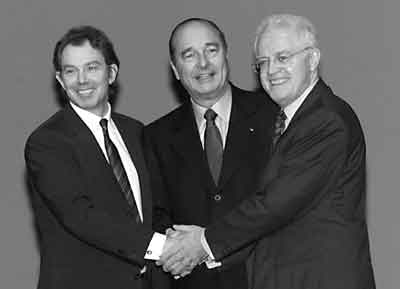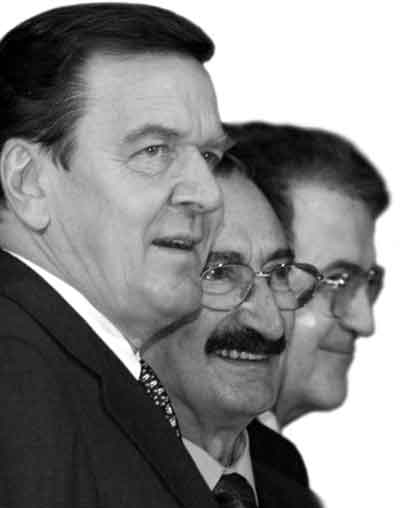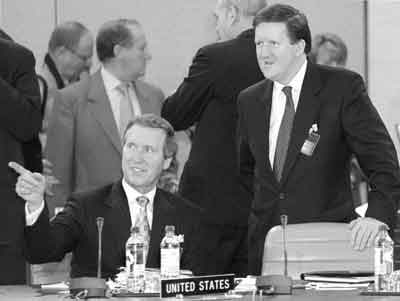Recent moves towards a common European defence and security policy and European defence capabilities that are separable but not separate from NATO have sparked off considerable debate. Concerns have been voiced that this could lead to a decoupling of Europes security from that of its other NATO allies, a duplication of effort or capabilities, and discrimination against those allies who are not European Union members. Franois Heisbourg argues that we need to get beyond the rhetoric of the three Ds. Difficult issues have been raised but there is nothing necessarily incompatible between the EU and NATO approaches. Above all, there is an urgent need for Europe to boost its capabilities, if it is not to be confined in future to a useful, but limited, reactive defence and security role.
Dormant for nearly 50 years, the inconclusive debate on European defence has taken a sudden leap forward since 1998, with major potential implications for NATO as a whole. First, in mid-1998, the British government decided that to improve European defence capabilities, it would be necessary to use the European Union (EU) as a framework. This was a change of Copernican proportions: after all, one of the reasons for the failure of attempts to establish a European Defence Community in the early 1950s was the British refusal to be part of it.
Second, the French government took this British sea change seriously. At their milestone bilateral meeting in St.-Malo (December 1998), they embraced the British emphasis on capabilities, while underscoring the role of the alliance.

French President Jacques Chirac (centre), Prime Minister Lionel Jospin (right) and his British counter-part, Tony Blair, shake hands at the end of their historic two-day meeting in St.-Malo, France 4 December 1998. (Belga photo - 7Kb)
Third, the glaring insufficiencies of Europes contribution in the prosecution of the Kosovo air campaign made it politically easier for the initiators of the St.-Malo process to generate support. In Cologne (June 1999) and Helsinki (December 1999), the 15 members of the EU took on board the need to improve defence capabilities in general and force projection in particular, while moving forward with setting up intergovernmental EU machinery to deal with defence issues. The traditional neutrality of certain EU members has not been an impediment to this remarkably swift process.
Concurrently, allied leaders at NATOs Washington summit (April 1999) endorsed the further development of a separable but not separate European Security and Defence Identity, while launching its own Defence Capabilities Initiative (DCI).
European problem, European response
To assess the implications of these changes, it is worth recalling what Europes problems actually are, when it comes to its defence capabilities and defence identity. They are not due to an insufficiency of overall defence spending. NATOs European members spend around 60 per cent of what the United States does on defence. With the limited exception of British and French commitments in the Gulf or in Africa, the European allies do not have collective defence commitments outside the NATO area, unlike the United States which has truly global responsibilities. In the post-Cold War context, 60 per cent should be more than enough to deal with contingencies inside and along the periphery of Europe. After all, that figure represents one-fifth of the worlds military expenditure!
Conversely, the Europeans do not get anything like 60 per cent of the United States capabilities from their defence spending. This is what the Kosovo campaign so starkly highlighted. Most of the European allies have defence budget structures, which are out of sync with the requirements of the post-Cold War era. Collectively, NATOs European members field standing forces of 2.4 million fully one million more than the United States with its global responsibilities. But spending on equipment and firepower is at US$ 11,000 per soldier in Europe versus US$ 36,000 per US soldier.
In other words, European defence is characterised by too much territorially based force structure on the one hand, and too little sustainable firepower ready for use where needed on the other. Only a few countries, notably Britain and France, devote a similar share of their defence budgets to acquisition, and operations and maintenance to that of the United States (58 per cent). If the EU countries as a whole moved to best European practice (currently in the United Kingdom), the money available each year for research and development and equipment would jump from 34 billion euros to 48 billion euros, without any increase in overall defence spending.
The corresponding lack of capability almost automatically translates into a limitation of responsibility when it comes to the planning and prosecution of military operations. Only those who bring decisive capabilities to the table can hope to effectively shape the strategy, rather than being confined to a useful, but limited, reactive role.

(Left to right) German Chancellor Gerhard Schroeder, Turkish Prime Minister Blent Ecevit and EU Commission President Romano Prodi at the EU summit in Helsinki, Finland, at which Turkey became eligible to apply for eventual EU membership 11 December 1999. (Reuters photo - 10Kb)
The Europeans need to improve the efficiency of their defence spending through a combination of approaches: defining force goals (this was done in terms of force projection capabilities at the EUs Helsinki summit); improving budget structures (so-called input criteria); and pooling key capabilities (what the French call mutualisation) such as air transport assets, in order to reduce the overhead costs and inefficiencies associated with having individual national armed forces.
This is basically a European problem, as opposed to an alliance-wide problem. US defence policy and spending, though not ideal, do not suffer from the same flaws as those of the Europeans. There is therefore a need to use primarily a European institutional frame-work, and preferably a powerful one the EU rather than the single-issue, politically less significant Western European Union (WEU). NATO can help through the Defence Capabilities Initiative, but the crux of the problem is in Europe as such, not NATO.
Empirical evidence supports this line of reasoning: ten years after the end of the Cold War, NATOs defence planning and review process has not led to the necessary and massive overhaul of the bloated European force structures inherited from the Cold War. The reform that has taken place has been achieved essentially through national measures. But defining force goals, establishing performance criteria and pooling assets requires a multilateral framework. The only option that carries enough political weight to address Europes structural defence weaknesses is the broad-based, deep-rooted European Union.
Damaging rhetoric
It would be a terrible waste if this essential reform process should lead to the opposite of what it set out to do if it weakened the alliance rather than strengthening it. Any estrangement between the European and North American allies as a result of the strengthened common European policy on security and defence should be avoided. In spite of the positive atmosphere and language of the Washington summit, there has been a serious risk of misunderstandings arising from the debate of European defence, in which repeated statements on the three Ds duplication, decoupling and discrimination have been a prominent feature. This rhetoric, which prevailed until December 1999, has been damaging because it stresses risks and negatives, rather than highlighting the positive. More seri-ously, it has created the impression that all the three Ds are inherently and equally negative. A closer examination makes it clear that this is not the case.
Duplication? If duplication were intrinsically negative, one could argue, ad absurdum, that Europe need not have any defence capability of its own, since there is little that it can field which the United States does not possess in abundance. Clearly, some duplication is necessary! What could be usefully discussed within NATO are the criteria for assessing the useful or damaging nature of duplication in specific areas. Furthermore, duplication should not be seen simply as a US-European debate: the problems of duplication are, if anything, worse among the Europeans than between the Europeans and the Americans. As a result, there are probably too many soldiers and certain types of equipment (main battle tanks, for example) in Europe today.
Duplication is no doubt useful in areas where all NATOs members are lacking. Air transport, SEAD (1) and OEW (2) , in-flight refuelling, GPS (3) guided ordnance, CALCMs (4) : these and others are no luxuries, and appropriate European advances in such fields will be positive for the alliance as a whole, including the United States, which may be in better shape than the Europeans in these areas, but definitely has no surfeit of capabilities. There are naturally grey areas, in which there can be serious and legitimate disagreement between NATO members as to the opportunity costs of certain types of duplication. Strategic reconnaissance is one of these.
So, the duplication issue deserves better than to be thrown into the same rubbish bin as decoupling, a clear negative in terms of alliance interests. But then, the Europeans are just as intent as the Americans on avoiding decoupling possibly more so.
Finally, we have discrimination. This is a serious, double-edged issue. If non-EU members of NATO focus understandably on the consequences of their potential exclusion from EU defence decision-making, there is the similar and no less vexing problem of the status of those EU members who are not part of NATO.
The issue of discrimination has to be handled with particular care. But the United States and non-EU members of NATO need to recognise that the Union is not simply a trading bloc, or merely a particularly tight international organisation. The process of European integration is of a quasi-constitutional nature. It is fated to develop a security and defence dimension, and some discrimination between members and non-members is by definition inevitable. The objective should therefore be to reduce the negative impact of discrimination, rather than pretending that it can be eliminated entirely.
The effects of discrimination need to be addressed as a matter of priority. As the EU deepens its involvement in security and defence affairs, its post-neutral members will be caught in a growing contradiction between their non-membership of NATO and the fact that the development of a common European defence and security policy is a process intimately tied to the Atlantic alliance.

NATO Secretary General Lord Robertson (right) and US Secretary of Defense William Cohen chat before the council meeting of NATO defence ministers in Brussels on 2 December 1999. (Belga photo - 10Kb)
A similar contradiction affects France. The issue of her full participation in a renewed NATO will have to be revisited as the European defence initiative progresses. It is hardly conceivable that European defence planning and NATO defence planning can be optimised and harmonised without complete French involvement. The common European defence policy could well lead France to take a new look at its positioning vis--vis NATO, in spite of the diplomatic fiasco of 1996-97, when the French-American disagreement on the future of NATOs Southern Command prevented the full participation of France in NATOs integrated command structure.
On the other, more traditional, side of the discrimination debate, it should not be too difficult for the EU to devise appropriate ways of associating non-EU members of NATO with European defence policy. After all, the Czech Republic, Hungary and Poland will probably be full members of the EU by the time the policy is ready to be implemented the rapid reaction force decided upon at the EU meeting in Helsinki is planned for 2003.
The status of Turkey in relation to European defence is of particular importance, given the countrys key strategic position and role. However, in this case the discrimination problem should be considerably mitigated by the momentous decision, also taken at Helsinki, to make Turkey eligible to apply for EU membership. The progress towards that goal will be arduous. But the sense of direction is now clear, and it would be surprising in that context if the EU and Turkey were not able to work out a constructive association on European defence issues.
That leaves, in terms of discrimination, Norway and Iceland. Neither the EU nor NATO should find it impossible to handle their situation with due care and consideration.
Beyond the three Ds
It is important for NATO and the EU to move beyond the rhetoric of the three Ds. The positive tone of US official comments after the Helsinki meeting hopefully demonstrates that this is now widely understood. The questions generated by the sudden and unexpected re-emergence of European defence are often difficult. But they can and should be addressed pragmatically, through setting up appropriate institu-tional interfaces, not least at the working level. The difficulties may be real but they are of a practical, rather than of an existential, nature. There is no prima facie incompatibility between the political and strategic principles contained in the relevant NATO decisions and those laid out in the fundamental European documents.

